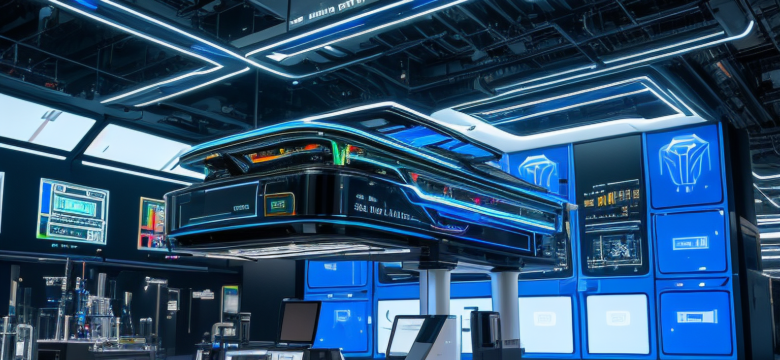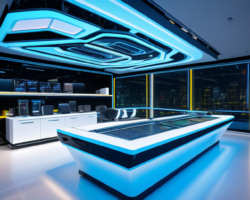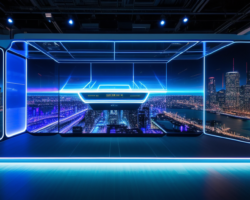Have you ever watched a sci-fi movie and thought, “Wow, that would be amazing if it were real?” Well, hold onto your hats, because the future is now! Groundbreaking technologies that once lived in the realm of fiction are now becoming integral to our daily lives. From artificial intelligence to space exploration, the innovations we once dreamed of are rapidly materialising around us.
Imagine a world where machines not only assist us but also learn and adapt to our needs. Artificial intelligence is leading the charge, revolutionising industries and enhancing our everyday tasks. Whether it’s through smart assistants or advanced algorithms, AI is changing the way we interact with technology, making our lives easier and more efficient.
But it doesn’t stop there! The cosmos is calling, and recent advancements in space exploration are reigniting our curiosity about the universe. With private companies entering the fray, the dream of commercial space travel is closer than ever. Can you imagine taking a vacation in space? The latest developments in space tourism are making this a reality for ordinary people, while plans for interplanetary colonisation are paving the way for human life beyond Earth.
As we dive deeper into these innovations, it becomes clear that the future holds limitless possibilities. The fusion of technology and imagination is not just transforming our world; it’s creating a new one. So, buckle up and get ready for a thrilling ride into a future that was once only a figment of our imagination!
Artificial Intelligence Advancements
Artificial intelligence is no longer just a buzzword; it has rapidly evolved into a transformative force that is reshaping our world. Imagine a world where machines can think, learn, and adapt just like humans. This is not a scene from a sci-fi movie; it’s the reality we are stepping into. From chatbots that provide customer service to complex algorithms that drive autonomous vehicles, AI is enhancing everyday tasks and revolutionising industries.
One of the most exciting aspects of AI is its ability to redefine human-machine interaction. Consider how voice assistants like Siri and Alexa have changed the way we interact with technology. No longer do we need to navigate complex menus; instead, we simply speak our commands. This seamless interaction opens up a world of possibilities, making technology more accessible to everyone.
Moreover, AI is making strides in sectors such as healthcare, where it assists in diagnosing diseases and personalising treatment plans. For instance, AI algorithms can analyse vast amounts of medical data to identify patterns that might elude human doctors. This not only enhances patient outcomes but also streamlines healthcare systems.
As we look to the future, the potential of AI is boundless. Whether it’s improving efficiency in industries or creating smarter cities, the advancements in AI are paving the way for a future that was once only imaginable. Are we ready to embrace this new era of innovation?
Space Exploration Breakthroughs
Space exploration has taken a giant leap forward, reshaping our understanding of the universe and our place within it. With advancements in technology, the once unfathomable idea of venturing beyond our planet is now on the brink of reality. From robotic missions that explore the surfaces of distant planets to telescopes that peer into the farthest reaches of space, the innovations are nothing short of astonishing.
Recent missions, such as NASA’s Perseverance Rover and the James Webb Space Telescope, have not only provided invaluable data but have also reignited global interest in space science. These projects are paving the way for future explorations, as they help us understand the potential for life on other planets and the origins of our own solar system.
Moreover, the emergence of private companies like SpaceX and Blue Origin has transformed the landscape of space travel. These companies are not merely participants; they are leaders, pushing boundaries and making space more accessible. For instance, SpaceX’s Starship aims to carry humans to Mars, while Blue Origin’s New Shepard is designed for suborbital space tourism.
As we look to the future, the dream of interstellar travel is becoming less of a fantasy and more of a goal. With ongoing research and development, the prospect of humans living on other planets is inching closer. Imagine a future where colonies on Mars are not just a concept but a thriving reality. The universe is calling, and thanks to these breakthroughs, we are poised to answer.
Commercial Space Travel
Imagine a world where hopping on a spacecraft for a weekend getaway is as routine as booking a flight to Paris. is not just a fantasy anymore; it’s becoming a thrilling reality! With private companies like SpaceX, Blue Origin, and Virgin Galactic leading the charge, the cosmos is opening up for civilians.
These pioneers are making space more accessible than ever. Just think about it: a few years ago, space was the exclusive domain of astronauts and scientists. Now, everyday people are gearing up for suborbital flights that last just a few minutes but offer breathtaking views of our planet. The excitement is palpable as we edge closer to a future where space tourism could become a multi-billion-pound industry.
So, what does this mean for you? Well, the first step is already here! Companies are offering flights to the edge of space, where passengers can experience weightlessness and witness the stunning curvature of the Earth. Just picture yourself floating in zero gravity, gazing back at our beautiful home planet! Here’s a snapshot of what’s currently on offer:
| Company | Flight Duration | Price |
|---|---|---|
| Virgin Galactic | Approximately 90 minutes | £200,000 |
| Blue Origin | Approximately 11 minutes | £250,000 |
| SpaceX | Multiple days (for orbital flights) | £50 million+ |
As technology continues to advance, the costs are expected to decrease, making space travel a reality for more adventurous souls. With plans for space hotels and even lunar vacations on the horizon, the sky isn’t the limit anymore—it’s just the beginning!
Space Tourism Developments
Space tourism is no longer a far-fetched fantasy; it’s becoming a tangible reality! Imagine gazing down at Earth from the comfort of a spacecraft, your heart racing with excitement and wonder. Thanks to pioneering companies like Virgin Galactic and Blue Origin, ordinary people are now on the brink of experiencing the cosmos firsthand.
These companies have made significant strides in developing commercial space travel, with ticket sales for suborbital flights already underway. Just think about it: for the price of a luxury car, you could be one of the few to witness the curvature of our planet and the vastness of space. The thrill of floating in zero gravity, even for a few minutes, is an experience that’s hard to put into words!
Furthermore, the advancements in technology are not just limited to space travel. They are also paving the way for a future where space hotels and orbital resorts might become commonplace. Imagine sipping your morning coffee while watching the stars twinkle just outside your window!
Here’s a quick overview of current developments in space tourism:
- Suborbital Flights: Companies like Virgin Galactic are offering short trips to the edge of space.
- Orbital Hotels: Plans are underway for hotels in low Earth orbit, allowing for extended stays.
- Future Missions: NASA and private firms are developing missions that could take tourists to the Moon and beyond.
As we stand on the brink of this new frontier, the dream of space tourism is not just a possibility; it’s an impending adventure waiting to be explored!
Interplanetary Colonisation Plans
Imagine waking up on a new planet, gazing at a sky filled with unfamiliar stars. Interplanetary colonisation is no longer just a dream; it’s a vision that’s gaining traction as scientists and engineers work tirelessly to make it a reality. The ambition to establish human habitats on planets like Mars is driven by the necessity of ensuring humanity’s survival and expanding our horizons beyond Earth.
Current plans revolve around several key areas:
- Technological Innovations: Advanced propulsion systems, life support technologies, and sustainable habitats are crucial for making long-term space living feasible.
- Resource Utilisation: Developing methods to use local resources, such as extracting water from Martian ice or utilising regolith for construction, is essential for self-sufficiency.
- International Collaboration: Efforts like NASA’s Artemis program and private ventures from companies such as SpaceX highlight the importance of global teamwork in this monumental task.
Moreover, the ethical implications of colonising other planets cannot be overlooked. As we venture into the cosmos, we must consider the impact on potential extraterrestrial life and the responsibilities we hold as caretakers of our own planet. The journey to Mars, for instance, is not just about reaching a new world, but also about ensuring that we learn from our past mistakes on Earth.
As we stand at the precipice of this new frontier, the question remains: are we ready to embrace the challenges of interplanetary living? The future is bright, and with each step we take, we move closer to making the extraordinary a part of our everyday reality.
Robotics in Everyday Life
Robots are no longer just the stuff of science fiction; they are becoming integral to our daily routines. Imagine waking up to a robotic vacuum that has already cleaned your floors while you slept! These smart machines are designed to take over mundane tasks, allowing us to focus on what truly matters. From household chores to complex surgeries, the integration of robotics into our lives is nothing short of revolutionary.
In the home, robots like the Roomba have made cleaning effortless. They navigate your space, avoiding obstacles while efficiently picking up dirt and debris. But it doesn’t stop there; in healthcare, robotic systems assist surgeons with precision that human hands alone cannot achieve. This fusion of technology and human skill has led to improved outcomes and faster recovery times for patients.
Furthermore, robots are making their mark in industries such as manufacturing and logistics. They streamline processes, reduce errors, and boost productivity. As we look to the future, the possibilities are endless. Will we soon see robots assisting in elderly care or even providing companionship? The answer is likely yes, as advancements in robotics continue to unfold.
In essence, robotics is reshaping our world, enhancing efficiency, and improving quality of life. As we embrace these innovations, one can’t help but wonder: how will we adapt to a future where robots are part of our everyday lives?
Biotechnology Innovations
Welcome to the fascinating world of , where science is not just pushing boundaries but is actively reshaping our existence! Imagine a realm where diseases are not just treated but prevented, and food production is optimised to feed the ever-growing population. This is not a distant dream; it’s happening now!
At the forefront of this revolution are groundbreaking technologies that are transforming healthcare and agriculture. For instance, advancements in CRISPR technology have made it possible to edit genes with remarkable precision. This means we can potentially eliminate genetic disorders before they even manifest. Think about it: a world where we can eradicate hereditary diseases before they pass from parent to child!
Moreover, the rise of personalised medicine is a game-changer in healthcare. Instead of a one-size-fits-all approach, treatments are now tailored to the individual’s genetic makeup, ensuring better outcomes. This shift is not just about improving health; it’s about enhancing the quality of life. The implications are profound, as patients receive therapies that are specifically designed for their unique biological profiles.
In agriculture, biotechnology is making waves by developing crops that are not only resistant to pests but also require fewer resources to grow. This innovation is crucial for sustainable farming practices. With climate change posing a significant threat to food security, these advancements offer a glimmer of hope. Imagine crops that can thrive in harsher climates or ones that yield more food without additional environmental strain!
In summary, biotechnology is not just a field of study; it’s a beacon of hope for our future. As we continue to harness these innovations, we are on the brink of a new era, one where science fiction becomes our everyday reality!
Genetic Engineering Breakthroughs
Genetic engineering is no longer just a concept confined to the pages of science fiction; it has become a transformative force reshaping our understanding of biology and medicine. With breakthroughs like CRISPR technology, scientists can now edit genes with unprecedented precision, opening doors to treating genetic disorders, enhancing crop resilience, and even combating climate change. Imagine being able to correct a hereditary disease before it manifests, or developing crops that can thrive in arid conditions—these possibilities are becoming tangible realities.
One of the most exciting aspects of these advancements is the ethical debate surrounding them. While the potential benefits are vast, concerns about designer babies and ecological impacts loom large. Striking a balance between innovation and ethical responsibility is crucial as we navigate this brave new world. For instance, researchers are exploring the implications of gene editing in humans, which raises questions about consent, equity, and the long-term effects on the gene pool.
Moreover, the agricultural sector is witnessing remarkable changes due to genetic engineering. With the global population projected to reach 9.7 billion by 2050, the need for sustainable food production methods has never been more urgent. Genetically modified organisms (GMOs) are being developed to withstand pests and diseases, thereby reducing the reliance on chemical pesticides and promoting a more sustainable approach to farming. Here’s a quick look at some key breakthroughs:
| Breakthrough | Description |
|---|---|
| CRISPR-Cas9 | A revolutionary gene-editing tool that allows for precise modifications in DNA. |
| Gene Drives | Technology that ensures a particular gene is passed on to nearly all offspring, potentially eradicating diseases. |
| Gene Therapy | A technique that modifies genes to treat or prevent diseases, including some forms of cancer. |
As we stand on the cusp of a genetic revolution, the implications of these breakthroughs are profound. They promise to not only enhance human health but also to revolutionise agriculture and environmental conservation. The future is indeed bright with possibilities, but it requires careful consideration of the ethical landscape we are stepping into.
Personalised Medicine Developments
Imagine a world where your treatment plan is as unique as your DNA. Personalised medicine is making this dream a reality, tailoring healthcare to the individual rather than a one-size-fits-all approach. This innovative field leverages genetic information, lifestyle factors, and environmental influences to create specific therapies that cater to the unique needs of each patient.
Recent advancements in genomics and biotechnology have paved the way for significant breakthroughs in this area. For instance, pharmacogenomics allows healthcare providers to determine how a patient’s genetic makeup affects their response to drugs, leading to more effective and safer medication choices. This means fewer side effects and improved recovery times, which is a win-win for patients and healthcare systems alike.
Moreover, the integration of artificial intelligence in analysing vast datasets is revolutionising the way we approach personalised medicine. By processing immense amounts of genetic data, AI can identify patterns and predict outcomes, enabling doctors to make informed decisions swiftly. This swift adaptability is crucial, especially in treating complex diseases like cancer, where every moment counts.
As we continue to break barriers in this exciting field, the future looks promising. With ongoing research and development, we can expect a surge in personalised therapies that not only enhance patient care but also improve overall health outcomes. The potential is limitless, and we are just scratching the surface of what personalised medicine can achieve!
Virtual and Augmented Reality
Virtual Reality (VR) and Augmented Reality (AR) are no longer just buzzwords; they are reshaping our world in profound ways. Imagine slipping on a headset and being transported to a breathtaking landscape, or overlaying digital information on your real-world surroundings. These technologies are revolutionising how we learn, play, and even work. In education, for instance, VR can immerse students in historical events, making learning a thrilling adventure rather than a mundane task.
Moreover, the entertainment industry is experiencing a seismic shift with the integration of VR and AR. Picture this: instead of merely watching a movie, you become part of the story, interacting with characters and influencing the plot. This level of engagement is something that traditional media simply cannot offer. The potential for storytelling is expanding, allowing creators to craft experiences that are not just watched but lived.
In addition, the applications of these technologies extend far beyond entertainment and education. Industries such as healthcare are utilising VR for training medical professionals, enabling them to practice procedures in a safe, controlled environment. This not only enhances their skills but also boosts confidence before they interact with real patients.
As we look to the future, the possibilities seem endless. AR is set to enhance our daily lives by providing real-time information, navigation, and even social interactions right in our line of sight. The fusion of digital and physical worlds is becoming more seamless, paving the way for a future where technology is an integral part of our reality.
Applications in Education
Imagine stepping into a classroom where the boundaries of reality blur, and learning becomes an adventure! Virtual Reality (VR) and Augmented Reality (AR) technologies are doing just that, revolutionising the way we educate. These immersive tools allow students to explore complex subjects in a hands-on manner, making learning not only effective but also incredibly engaging.
For instance, in a history lesson, students can don VR headsets and find themselves walking through ancient civilisations, experiencing history as if they were there. This kind of experiential learning captivates students’ imaginations and enhances retention. But it doesn’t stop there; AR can bring static textbooks to life, overlaying digital information onto the real world. Imagine a biology class where students can see 3D models of the human body right on their desks!
Moreover, these technologies are not just fun and games; they also cater to diverse learning styles. Visual learners can benefit from dynamic visuals, while kinesthetic learners can interact with the material. As we embrace these innovations, we can expect a future where education is tailored to the needs of every student, fostering a more inclusive and effective learning environment.
In summary, the applications of VR and AR in education are transforming traditional teaching methods into an engaging and interactive experience. The potential for enhanced understanding and student engagement is limitless, paving the way for a new era of learning.
Entertainment Industry Transformations
The entertainment industry is undergoing a remarkable transformation thanks to the integration of Virtual Reality (VR) and Augmented Reality (AR) technologies. Imagine stepping into a movie scene or interacting with your favourite characters as if they were right beside you! This is no longer a fantasy; it’s becoming a reality, and it’s changing how we consume content.
These immersive technologies allow creators to craft experiences that engage audiences on a whole new level. For instance, VR can transport viewers into a 360-degree world where they can explore settings and narratives actively rather than passively watching. This interactivity fosters a deeper emotional connection, making stories more impactful.
Moreover, the gaming sector is reaping the benefits of these advancements. Players can now experience games that blend the digital and real worlds, creating a sense of presence that was previously unimaginable. As a result, gaming is evolving into a social platform where players can interact and collaborate in ways that mirror real-life experiences.
In addition to gaming, the film industry is experimenting with AR to enhance storytelling. Imagine watching a movie and having additional information about the characters or settings pop up in your field of vision. This blend of reality and fiction opens up new avenues for creativity.
As we look to the future, the question remains: how will these technologies further redefine our entertainment landscape? With continuous innovation, the possibilities are endless, and we are just scratching the surface of what’s possible!
Energy Solutions of the Future
The quest for sustainable energy solutions is more urgent than ever. As we face the consequences of climate change, innovative technologies are emerging to reshape how we produce and consume energy. From solar farms in the desert to wind turbines on the coast, the landscape of energy generation is evolving rapidly. These advancements not only promise to reduce our carbon footprint but also enhance energy security and accessibility for all.
Among the most exciting developments are renewable energy technologies. Solar panels have become more efficient, harnessing sunlight like never before. Wind energy is also surging, with larger turbines capturing more power from the winds. Notably, countries are investing heavily in these technologies, leading to a significant drop in costs. According to recent data, the price of solar energy has decreased by over 80% in the past decade, making it an attractive option for both consumers and businesses.
However, the challenge lies in energy storage innovations. To fully utilise renewable sources, we need effective storage solutions that can hold energy for when it’s most needed. Breakthroughs in battery technology, such as lithium-sulfur and solid-state batteries, are paving the way for more reliable storage systems. These innovations are critical for ensuring that renewable energy can power our homes and industries, even when the sun isn’t shining or the wind isn’t blowing.
In conclusion, the future of energy is bright, filled with potential and promise. As we continue to innovate and invest in renewable sources and storage technologies, we can look forward to a greener, more sustainable world. The transition to these energy solutions is not just about technology; it’s about creating a better future for generations to come.
Renewable Energy Technologies
As we stand on the brink of an energy revolution, are leading the charge towards a more sustainable future. Gone are the days when fossil fuels dominated the energy landscape; now, we are witnessing a remarkable shift towards harnessing the power of nature. Imagine a world where the sun, wind, and water are our primary energy sources—this is not just a dream, but a reality that is rapidly unfolding.
Solar panels are becoming ubiquitous, transforming rooftops into mini power stations. With advancements in photovoltaic technology, the efficiency of these panels has skyrocketed, making solar energy more accessible than ever. Additionally, wind turbines have evolved into towering giants that harness the relentless power of the wind, generating clean energy for millions. These innovations are not only reducing our carbon footprint but also creating jobs and stimulating economic growth.
Moreover, the integration of renewable energy sources into our grid is essential for a sustainable future. For instance, smart grid technology allows for better management of energy distribution, ensuring that renewable sources can be effectively utilised. The table below highlights some key renewable energy technologies and their benefits:
| Technology | Benefits |
|---|---|
| Solar Energy | Reduces electricity bills, low maintenance costs |
| Wind Energy | Clean and abundant, creates jobs in manufacturing |
| Hydropower | Reliable and efficient, provides flood control |
In conclusion, the future of energy lies in our ability to embrace these renewable technologies. As we continue to innovate and invest in these solutions, we not only protect our planet but also pave the way for a greener, more sustainable world. Are you ready to join this exciting journey towards a cleaner energy future?
Energy Storage Innovations
As we venture into an era where renewable energy is becoming increasingly vital, are paving the way for a sustainable future. Imagine a world where the sun shines brightly during the day, yet the energy captured can power our homes at night. This is no longer a fantasy; it’s a reality being shaped by cutting-edge technologies.
One of the most significant breakthroughs in this field is the development of advanced battery technologies. Traditional lithium-ion batteries are being enhanced, while alternatives such as solid-state batteries and flow batteries are gaining traction. These innovations promise not only higher energy density but also improved safety and longevity. For instance, solid-state batteries can potentially double the range of electric vehicles, making them more appealing to consumers.
Moreover, energy storage solutions are not limited to batteries. Technologies like pumped hydro storage and compressed air energy storage are also playing crucial roles in stabilising energy supply. These methods allow excess energy generated during peak production times to be stored and released when demand surges, ensuring a consistent energy flow. The table below outlines some of the key energy storage technologies and their benefits:
| Technology | Benefits |
|---|---|
| Solid-State Batteries | Higher energy density, improved safety |
| Flow Batteries | Longer lifespan, scalable solution |
| Pumped Hydro Storage | Proven technology, large capacity |
| Compressed Air Energy Storage | Flexible and efficient for large-scale storage |
In conclusion, as we continue to innovate and refine these technologies, we are not just enhancing energy storage; we are transforming the way we think about energy consumption. With these advancements, we are on the brink of a new age where renewable energy can be harnessed and stored effectively, ensuring a cleaner, greener planet for generations to come.
Frequently Asked Questions
- What are some examples of artificial intelligence advancements?
Artificial intelligence has seen remarkable growth in areas like natural language processing, machine learning, and robotics. These advancements enable machines to perform tasks ranging from language translation to complex data analysis, making our lives easier and more efficient.
- How close are we to commercial space travel?
We’re closer than ever! Companies like SpaceX and Blue Origin are leading the charge, with successful test flights and plans for future missions. The dream of ordinary people travelling to space is becoming a reality, with ticket sales expected to start soon.
- What role do robots play in our daily lives?
Robots are increasingly becoming part of our routines, from robotic vacuum cleaners to advanced surgical robots in hospitals. They help with mundane tasks and improve precision in critical areas, enhancing our quality of life.
- How is biotechnology changing healthcare?
Biotechnology is revolutionising healthcare through personalised medicine, which tailors treatments to individual genetic profiles. This approach leads to better outcomes and more effective therapies for patients.
- What impact do virtual and augmented reality have on education?
VR and AR are transforming education by providing immersive learning experiences. Students can explore virtual environments or interact with augmented content, making lessons more engaging and memorable.
- Are renewable energy technologies effective?
Absolutely! Renewable energy technologies like solar and wind are becoming more efficient and cost-effective. They offer sustainable solutions to our energy needs while reducing environmental impact.





